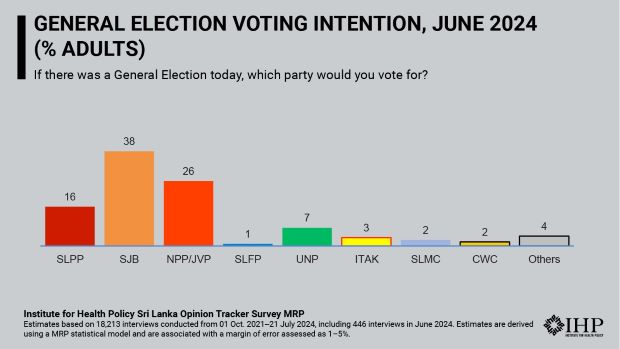COLOMBO —Support for Sri Lanka’s National People’s Power (NPP), the leftist political formation, declined to 26% in June, while the main opposition Samagi Jana Balawegaya (SJB) increased its lead to 38%, according to a voting intent survey conducted by the Institute for Health Policy (IHP).
The survey found support for the NPP dropped by 5 points in June, while the SJB increased its support by 1 percentage point.
The ruling Sri Lanka Podujana Peramuna (SLPP) had gained two percentage points to move up to 16%, while President Ranil Wickremesinghe’s United National Party (UNP) had gained one point to reach 7%.
The Ilankai Thamil Arasu Kachchi (ITAK) saw its support decrease by 1 point to 3% in June.
The IHP said in a statement on Wednesday (July 31) that the June estimates are provisional and are associated with a margin of error of 4–5% for the two leading parties.
Compared to IHP’s June release, estimates of NPP and SJB support in May 2024 were revised -3 and +3 points respectively, the institute said.
However, the margin of error increased substantially in the June estimates, the IHP said advising caution in interpreting recent trends and noting that it will expand interview numbers in the coming weeks to resolve any uncertainties.
It explained that the estimates were for all adults and not for likely voters and were based on the January 2024 revision of the IHP SLOTS Multilevel Regression and Post-stratification (MRP) model.
“IHP is working on improving its likely voter model and will resume the release of voting intent in likely voters in a future update. It should be noted that differences in voting intent shares between all adults and likely voters have typically been 1–2% for most estimates in the past two years,” the IHP said.
According to the institute, the June 2024 update is based on 18,213 interviews conducted with adults across Sri Lanka since October 2021, including 446 interviews carried out in June 2024.
“IHOP’s SLOTS MRP methodology first estimates the relationship between a wide variety of characteristics about respondents and their opinions – in this case, ‘If there was a General Election today, which party would you vote for?’– in a multilevel statistical model. It then uses a large data file that is calibrated to the national population to predict voting intent in each month since October 2021, according to what the multilevel model says about their probability of voting for various parties (‘post-stratification) at each point in time. The multilevel model was estimated 100 times to reflect underlying uncertainties in the model and to obtain margins of error. The voting intent results for previous months have changed in this update as more data were collected after the last release, and these changes are within the margin of error,” the institute said.
-economynext.com



Comments are closed, but trackbacks and pingbacks are open.